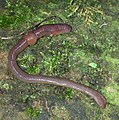Hvirvelløse dyr
Hvirvelløse dyr (invertebrata) betyder direkte "uden rygsøjle" eller "uden ryghvirvler" i modsætning til hvirveldyr. Denne gruppe indeholder med andre ord alle de dyr, der ikke har en rygrad. Det vil sige alt andet end fisk, padder, krybdyr, pattedyr og fugle findes i denne gruppe.
Sækdyr, trævlemunde og lancetfisk er rygstrengsdyr der ikke betegnes hvirveldyr.[1]
Eksempler på dyr uden rygsøjle
- Edderkop
Leddyr (Arthropoda) - Goppel
Nældecelledyr/Polypdyr (Cnidaria) - Regnorm
Ledorme (Annelida) - Søpindsvin
Pighuder (Echinodermata) - Elefantøresvamp (orange)
Havsvampe (Porifera) - Vinbjergsnegl
Bløddyr (Mollusca) - Fladorme
Fladorme (Platyhelminthes) - Mosdyr
Mosdyr (Bryozoa)
Henvisning
- ^ Jørgen Mørup Jørgensen (2003). Introduktion til Chordatzoologi. Gads Forlag.
Medier brugt på denne side
Forfatter/Opretter: , Licens: CC BY-SA 4.0
Burrowing urchin
Forfatter/Opretter: Michael Linnenbach, Licens: CC BY-SA 3.0
Ver de terre (Oligochaeta, Lumbricina)
For index to numbers, see here
- Cercaria dichotoma (Johannes Müller) / Distoma sp. = Gymnophallus choledochus Odhner,1900 / Gymnophallus rebecqui Bartoli, 1983, cercaria larva from below
- Cercaria spinifera (La Valette) = Echinostoma echinatum (Zeder, 1803), cercaria larva from below
- Cercaria bucephalus (Ercolani) / Gasterostomum fimbriatum (Siebold) =? Bucephalus polymorphus Baer, 1827, cercaria larva from above
- Polystomum integerrimum (Rudolphi) = Polystoma integerrimum (Fröhlich, 1791), adult from below
- Polystomum integerrimum (Rudolphi) = Polystoma integerrimum (Fröhlich, 1791), miracidium larva
- Gyrodactylus elegans (Nordmann) = Gyrodactylus elegans von Nordmann, 1832, adult from below
- Diplozoon paradoxum (Nordmann) = Diplozoon paradoxum von Nordmann, 1832, mated pair from below
- Tristomum coccineum (Cuvier) = Tristoma coccineum (Cuvier, 1817), adult from below
- Callicotyle Kroyeri (Diesing) = Calicotyle kroyeri Diesing, 1850, adult from below
- Caryophyllaeus mutabilis (Rudolphi) = Caryophyllaeus laticeps (Pallas, 1781), adult
- Tetrarhynchus longicollis (Cuvier) = Tetrarhynchus longicollis van Beneden, 1849 / Halysiorhynchus longicollis (van Beneden, 1849), young adult
- Phyllobothryon gracile (Van Beneden) = Phyllobothrium gracile Wedl, 1855, head from the front
- Taenia solium (Rudolphi) = Taenia solium Linnaeus, 1758, mature proglottid
- Taenia solium (Rudolphi) = Taenia solium Linnaeus, 1758, head from the front
Forfatter/Opretter: Jürgen Schoner, Licens: CC BY-SA 3.0
Picture of a grapevine snail.
An orange Elephant Ear sponge (Agelas clathrodes) at the Florida Keys National Maritime Sanctuary. In the background is a deep water sea fan (Iciligorgia schrammi), and the giant slit-pore sea rod (Plexaurella nutans). These soft corals are actually slow moving animals but are often mistaken for plants. (elephant ear sponge at the Florida Keys National Maritime Sancturay)
Enlarge image for index to numbers.
- Cristatella mucedo (Cuvier) = Cristatella mucedo Cuvier 1798, immature statoblast
- Cristatella mucedo (Cuvier) = Cristatella mucedo Cuvier 1798, mature statoblast
- Cristatella mucedo (Cuvier) = Cristatella mucedo Cuvier 1798, young colony
- Cristatella mucedo (Cuvier) = Cristatella mucedo Cuvier 1798, mature colony
- Cristatella mucedo (Cuvier) = Cristatella mucedo Cuvier 1798, mature colony in cross-section
- Plumatella repens (Lamarck) = Plumatella repens (Linnaeus 1758), individual before colony formation
- Plumatella repens (Lamarck) = Plumatella repens (Linnaeus 1758), young colony
- Plumatella repens (Lamarck) = Plumatella repens (Linnaeus 1758), part of young colony
- Alcyonella flabellum (Van Beneden) = Plumatella fungosa (Pallas 1768), young colony
- Lophopus crystallinus (Dumortier) = Cristatella mucedo Cuvier 1798, young colony
- Lophopus crystallinus (Dumortier) = Cristatella mucedo Cuvier 1798, young developing individual in colony
- Lophopus crystallinus (Dumortier) = Cristatella mucedo Cuvier 1798, older developing individual in colony
Forfatter/Opretter: User:Fir0002, Licens: CC BY-SA 3.0
Mexican redknee tarantula (Brachypelma smithi)















